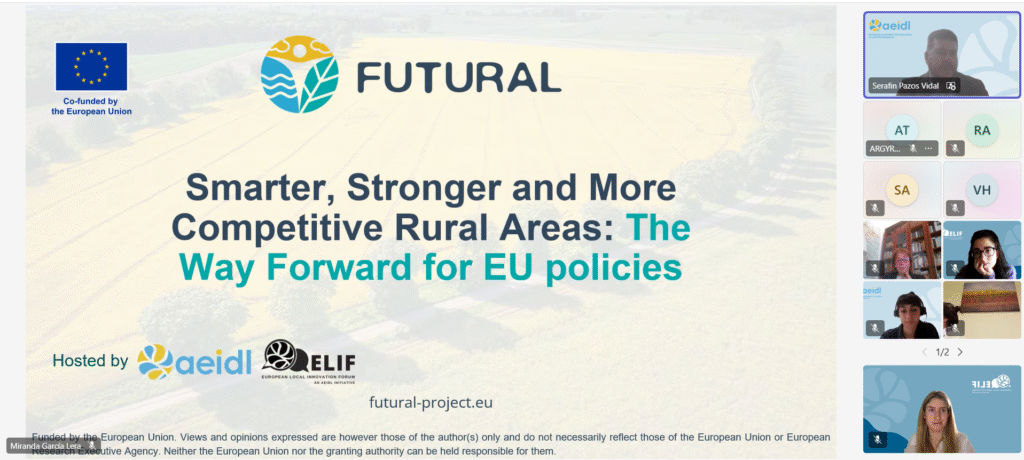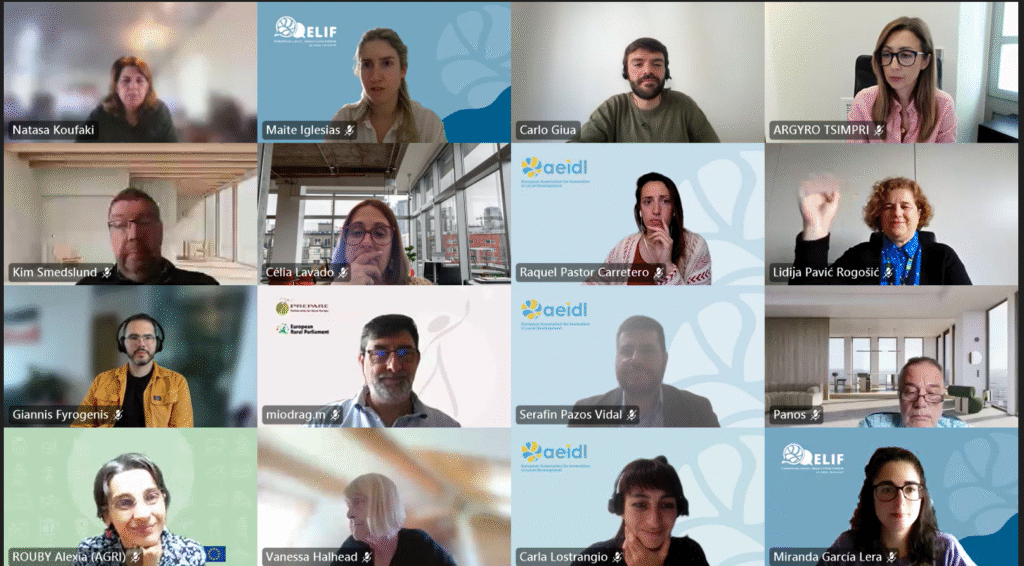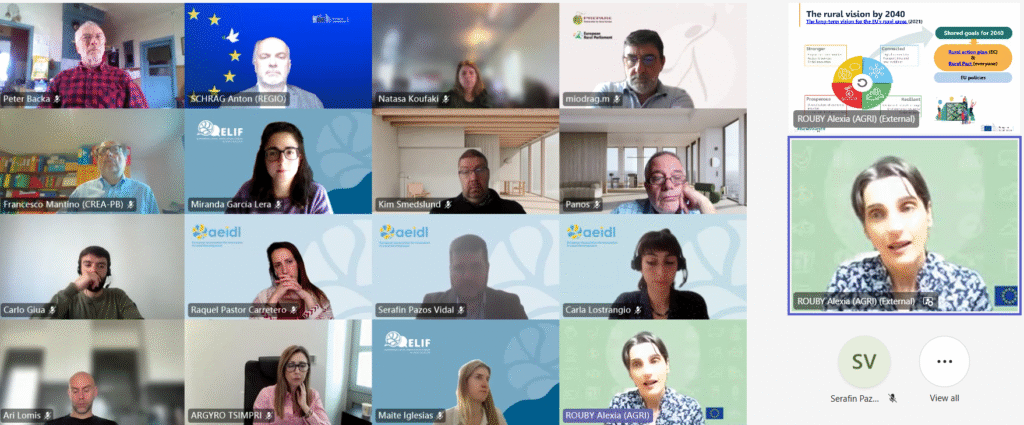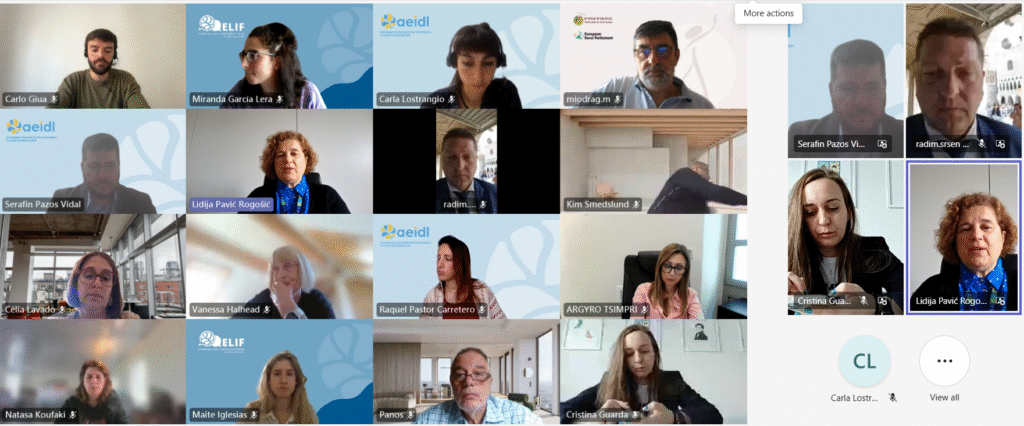The FUTURAL Policy Webinar “Smarter, Stronger and More Competitive Rural Areas: The Way Forward for EU policies” presented the findings of the project’s policy analysis on existing support for community-led innovation in rural areas, showcasing country-specific practices, and discussing policy needs, gaps, and recommendations for the 2028–2034 programming period, including a first set of proposed policy recommendations. Organised by the European Association for Innovation in Local Development (AEIDL) and supported by the European Local Innovation Forum (ELIF), the event brought together representatives from EU institutions and rural networks to explore how rural innovation can inform and shape the future direction of EU policies.
Community-led rural innovation in EU policy agendas
Held on 21 st May 2025, the webinar convened over 142 participants from across Europe, at a crucial moment as EU Institutions are preparing the next Multiannual Financial Framework (MFF), to be tabled in July 2025. As such, the webinar offered an opportunity to gather input from key EU institutions —the European Commission, European Parliament, Committee of the Regions, and European Economic and Social Committee— as well as the Leaders of pan-European networks ELARD, ERCA, and PREPARE, to discuss how rural innovation can be better aligned with future EU policies.
This event builds from the Political Guidelines of the European Commission, themselves drawing ideas from the Letta and Draghi Reports, as well as the EU’s Long-Term Vision for Rural areas and the recent Vision for Agriculture and Food. All these points highlight the need for major changes in how EU policies are developed and delivered on the ground. The webinar also built on a series of previous policy dialogues, including the European Local Innovation Forum (ELIF) in November 2024, the RURACTIVE Forum in February 2025, and the recent FUTURAL EU Rural Innovation Forum (EU-RIF) held in Amorebieta-Etxano (Basque Country, Spain). These events fostered the emergence of an active European policy community on rural innovation.
From analysis to policy recommendations
The webinar opened with remarks from Márta Marczis, President of AEIDL, who reflected on the recent AEIDL’s policy statement on the next Multiannual Financial Framework (MFF) and particularly on the place of the local level in a European project that faces new challenges. AEIDL is keen to emphasise the importance of a bottom-up approach to support the European project and values. In a context where there is significant likelihood of centralisation at the EU and national level of the post 2027 EU funds and programmes, AEIDL advocates for greater empowerment of local actors and the pooling of resources at the local level, involving local actors in decision-making to strengthen the democratic process.
This set the stage for the central question of the event: How do current and future EU policies support rural innovation and community-led development?
Carla Lostrangio (AEIDL) provided an overview of the findings from the FUTURAL policy analysis on community-led innovation in rural areas. A main takeaway that innovation policies rarely directly or explicitly targeted at rural areas and even less to communities.
The analysis stressed the need to reinforce rural innovation through clear budget lines both in the CAP and Cohesion Policy, strengthening tools such as the Smart Villages instrument, CLLD/LEADER, and beyond those across other innovation policies (e.g. digital/social, industrial policies).
Following this, Alexia Rouby (DG AGRI – European Commission) offered insights into the EU-level policy framework for rural innovation and competitiveness. She underlined the need for communities to “invent new solutions to the challenges they face,” building on the extensive opportunities provided by the EU Long-Term Vision for Rural Areas, the EU Rural Action Plan and the EU Vision for Food and Agriculture, emphasising that skills development and investments are vital enablers to rural innovation. She also invited actors to engage with the Commission providing ideas for the update of the Rural Action Plan due by 2025 or early 2026.
In the same line, Anton Schrag (DG REGIO – European Commission) stressed that Europe is facing an issue with competitiveness and underlined that “only 4% of the total value added created in rural areas comes from agriculture and forestry, whereas 30% of the GDP in these areas comes from industry and construction”.In this framework, Cohesion Polich has a big role to play to strengthen rural innovation. He also noted that while part of the future EU budget will support the European Competitiveness Fund, the European Commission President has assured that there will be a dedicated focus on cohesion, support for farmers, and continued investment in research and innovation.
In addition, Serafin-Pazos-Vidal (AEIDL) presented the initial FUTURAL policy recommendations, validated at the first meeting of the European Rural Innovation Forum. These 8 recommendations aim to strengthen smart, community-led innovation in the post-2027 EU policy landscape:
● Formal Recognition of the transformative role of community-led Innovation Mainstream Political & Financial Support with 8% Mandatory Earmarking and Territorially Proof all EU Policies
● Apply the ‘Do not harm to EU Cohesion’ principle across all territorially relevant EU policies• Align Rural Development with Sectoral Policies reinforcing existing Governance mechanisms
● Shift the Focus to Rural Innovation Ecosystems rather than individual Solutions
● Allow Regulatory Flexibility to allow innovation to happen now
● Enhance Digital Skills & infrastructures, with caution on marginalized communities
● Systematise Inclusion of Local Voices beyond Token Approaches
Sharing experiences
Argyro Tsimpri (Vice-President of ELARD), Vanessa Halhead (Coordinator of ERCA), and Guoda Burokiene (President of PREPARE) shared concrete examples of rural innovation practices from across Europe. They highlighted emerging trends influencing rural innovation — such as digital transformation, demographic decline and ageing populations, green transition and the need for bottom-up governance— and identified key barriers and gaps that persist across EU regions, including limited digital infrastructure, bureaucratic complexity, insufficient support for voluntary local initiatives, and fragmented or poorly aligned policies.
The speakers also offered recommendations for future EU programming, calling for dedicated rural programmes beyond agriculture, simplified and harmonised funding rules, and the recognition of Local Action Groups (LAGs) and existing rural networks as rural innovation hubs. They advocated for greater support for civil society organisations, transnational cooperation, and institutionalised rural proofing. In a final round table, representatives of EU institutions reflect on what post-2027 EU policies should look like to further support community-led innovation.
Cristina Guarda (MEP) underlined that Cohesion Policy still does not provide sufficient support to rural innovation, noting that even though some helpful tools like CLLD and smart solutions exist, they often don’t reach the most vulnerable or innovative areas. She stressed the need for a “genuine EU strategy” for community-led rural innovation, built on local participation, dedicated funding, and stronger rural proofing mechanisms across EU policies.
Lidija Pavic-Rogosic (European Economic and Social Committee) pointed out that EU rural policy is too divided and not well coordinated. She said that areas like agriculture, digital technology, skills, cohesion, and research should work more closely together. She called for mandatory rural proofing, simplified access to EU funds, and stronger support for civil society and intermediary organisations.
Radim Sršeň (European Committee of the Regions) stressed the importance of focusing on solutions rather than obstacles, urging policymakers to make better use of existing tools to support innovation in rural areas. He noted that challenges like energy and population changes can also bring new opportunities if the right tools are used. However, he warned that upcoming allocation negotiations risk weakening the partnership principle and subsidiarity, and called for place-based, tailor-made approaches, such as the LEADER programme.
What’s next?
The FUTURAL project will integrate the outputs of this discussion into its forthcoming report on Existing Policy and Governance Frameworks for Smart Community-led Innovation, to be published in the coming months on FUTURAL website.
Interested to continue engaging on local development and rural innovation?
This event was supported by the European Local Innovation Forum (ELIF). You can join our next ELIF events here




Below you can find the event’s presentations
Carla Lostrangio (AEIDL), Results from the FUTURAL Policy Analysis: Commynity-led Innovation in rural areas
Alexia Rouby (DG AGRI – European Commission), Rural Innovation and competitiveness in EU Policies
Serafin-Pazos-Vidal (AEIDL), FUTURAL Policy Recommendations from rural areas


